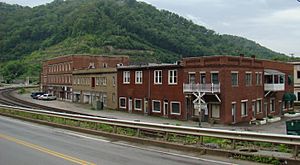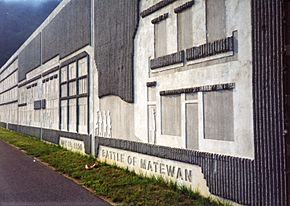Battle of Matewan facts for kids
Quick facts for kids Matewan Massacre |
|||
|---|---|---|---|
| Part of the West Virginia coal wars | |||
| Date | May 19, 1920 | ||
| Location |
Matewan, West Virginia, United States
|
||
| Resulted in | A setback for miners' rights until the early 1930s when the Government finally recognized American labor unions. Eventual passage of the National Industrial Recovery Act of 1933 | ||
| Parties to the civil conflict | |||
|
|
|||
| Lead figures | |||
|
|||
| Number | |||
|
|||
| Casualties | |||
|
|||
The Matewan Massacre was a big shootout that happened on May 19, 1920. It took place in the small town of Matewan in Mingo County. This event was a key part of the West Virginia coal wars. These wars were struggles for better rights for coal miners.
The fight was between local coal miners and a group of detectives. These detectives worked for the Baldwin–Felts Detective Agency. Many people died in the shootout. Among them were the town's mayor, Cabell Testerman, and two brothers who owned the detective agency.
Contents
What Was the Matewan Massacre?
The Matewan Massacre is also known as the Battle of Matewan. It was a violent clash in the Pocahontas Coalfield mining area. This area is in southern West Virginia. The detectives were hired by the Stone Mountain Coal Company. They came to Matewan to force miners' families out of their homes. These homes were owned by the coal company.
After evicting several families, the detectives were leaving town. But the Matewan Chief of Police, Sid Hatfield, stopped them. He said he had warrants to arrest them. Hatfield supported the miners who wanted to join the United Mine Workers of America (UMWA) union. One of the detectives, Albert Felts, then tried to arrest Hatfield. Matewan Mayor Cabell Testerman looked at the warrant. He said it was fake.
Unknown to the detectives, armed miners were watching them. They were hidden in buildings along Mate Street. It's not clear who fired the first shot. But a gunfight started on the porch of the Chambers Hardware Store. This fight became known as the Matewan Massacre. Seven detectives and three townspeople died. This included the Felts brothers and Mayor Testerman. Miners and their supporters saw this battle as a victory. It showed how serious the fight for miners' rights had become.
Why Miners Were Unhappy
At this time, John L. Lewis had just become president of the United Mine Workers of America. Miners worked very long hours in dangerous conditions. They also earned very low wages. To make things harder, the Stone Mountain Coal Company paid them with coal scrip. This was like company money. It could only be used at the company's own stores.
A few months before the Matewan fight, other union miners went on strike. They won a 27 percent pay raise. Lewis saw that miners in southern Appalachia were ready for change. He planned to help them form a union. The union sent its best organizers, including the famous Mary Harris "Mother" Jones.
About 3,000 men joined the union in the spring of 1920. They signed their union cards at the community church. They knew this could cost them their jobs and homes. Coal companies controlled many parts of the miners' lives. The Stone Mountain Coal Corporation fought back. They fired many workers, harassed them, and evicted them from their homes.
Matewan: A Town Divided
Matewan was a small, independent town founded in 1895. It had only a few elected officials. Cabell Testerman was the mayor. Sid Hatfield was the chief of police. Both the mayor and the police chief supported the miners. They refused to give in to the company's demands.
The Stone Mountain Coal Corporation hired the Baldwin–Felts Detective Agency. Miners called them the "Baldwin Thugs." Their job was to evict miners and their families from company-owned houses. Because of this, hundreds of miner families lived in tents in the spring of 1920. This tent community was called the Stony Mountain Camp Tent Colony.
The Day the Shots Rang Out
On the day of the fight, Baldwin–Felts detectives arrived. They were there to evict families from the coal camp outside Matewan. The sheriff and his deputy, Fred Burgraff, sensed trouble. They met the detectives at the train station. News of the evictions quickly spread through town.
When Sid Hatfield approached the detectives, Albert Felts tried to arrest Hatfield. Burgraff's son later said the detectives had sub-machine guns. Hatfield, Burgraff, and Mayor Cabell Testerman met with the detectives. They stood on the porch of the Chambers Hardware Store. It's still not known who fired the first shot. Some say Hatfield shot Felts after Felts shot Mayor Testerman. Others say Hatfield shot Felts first.
After the detective and mayor were wounded, Sid Hatfield kept firing. Felts tried to escape into the Matewan Post Office. Hatfield found him there and shot him. When the shooting stopped, townspeople came out. Many were wounded. Seven Baldwin–Felts detectives were killed, including Albert and Lee Felts. One more detective was wounded. Two miners also died: Bob Mullins, who had just been fired for joining the union, and Tot Tinsley, an innocent bystander. The wounded mayor died, and four other bystanders were hurt.
What Happened Next
Governor John J. Cornwell ordered the state police to take control of Matewan. Hatfield and his men cooperated. They put their weapons inside the hardware store. The miners felt stronger after getting the detectives out of Matewan. They worked even harder to organize their union.
On July 1, the miners' union went on another strike. Widespread violence broke out. Railroad cars were blown up, and strikers were beaten. The violence was so bad that the government had to declare martial law. Federal troops were sent in to help.
The trial for the miners accused of killing the seven agents began on January 26, 1921. It ended on March 19, 1921. All the accused miners were found not guilty.
Tom Felts, the last remaining Felts brother, sent secret agents to gather evidence against Sid Hatfield. When the murder charges against Hatfield were dropped, Baldwin–Felts detectives killed Hatfield. They also killed his deputy, Ed Chambers. This happened on August 1, 1921, on the steps of the McDowell County courthouse in Welch.
Less than a month later, miners from the state gathered in Charleston. They were even more determined to organize the southern coal fields. They began a march to Logan County. Thousands of miners joined them along the way. This march led to what is now known as the Battle of Blair Mountain.
The Matewan Historic District was added to the National Register of Historic Places on April 27, 1993. This means it is recognized as an important historical site.
In Movies and Books
- The 1987 film Matewan by John Sayles tells the story of the battle.
- A silent movie called Smilin' Sid showed Sid Hatfield as a hero. It was shown in union mining camps.
- The battle is also part of Glenn Taylor's 2008 novel The Ballad of Trenchmouth Taggart.



